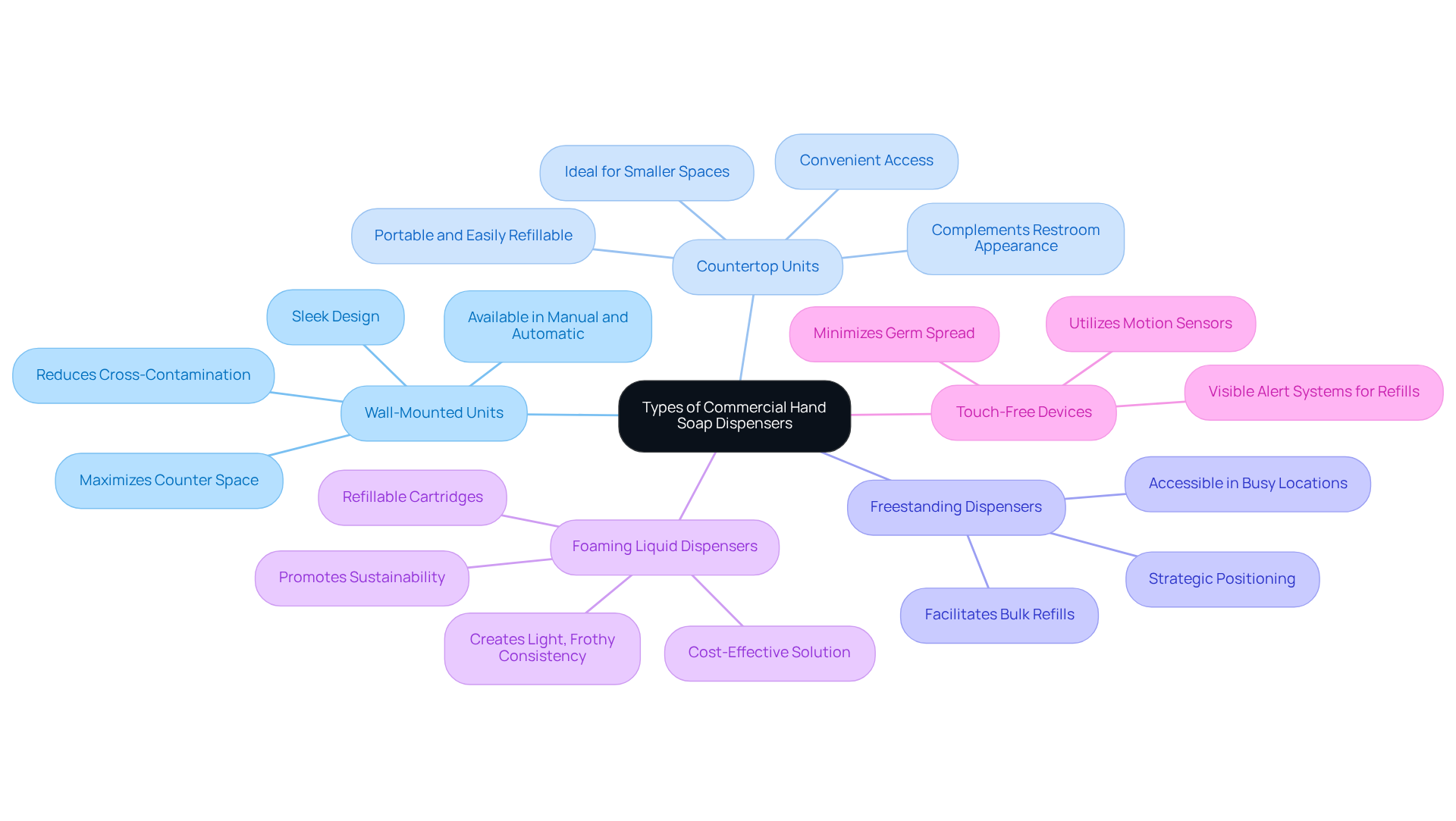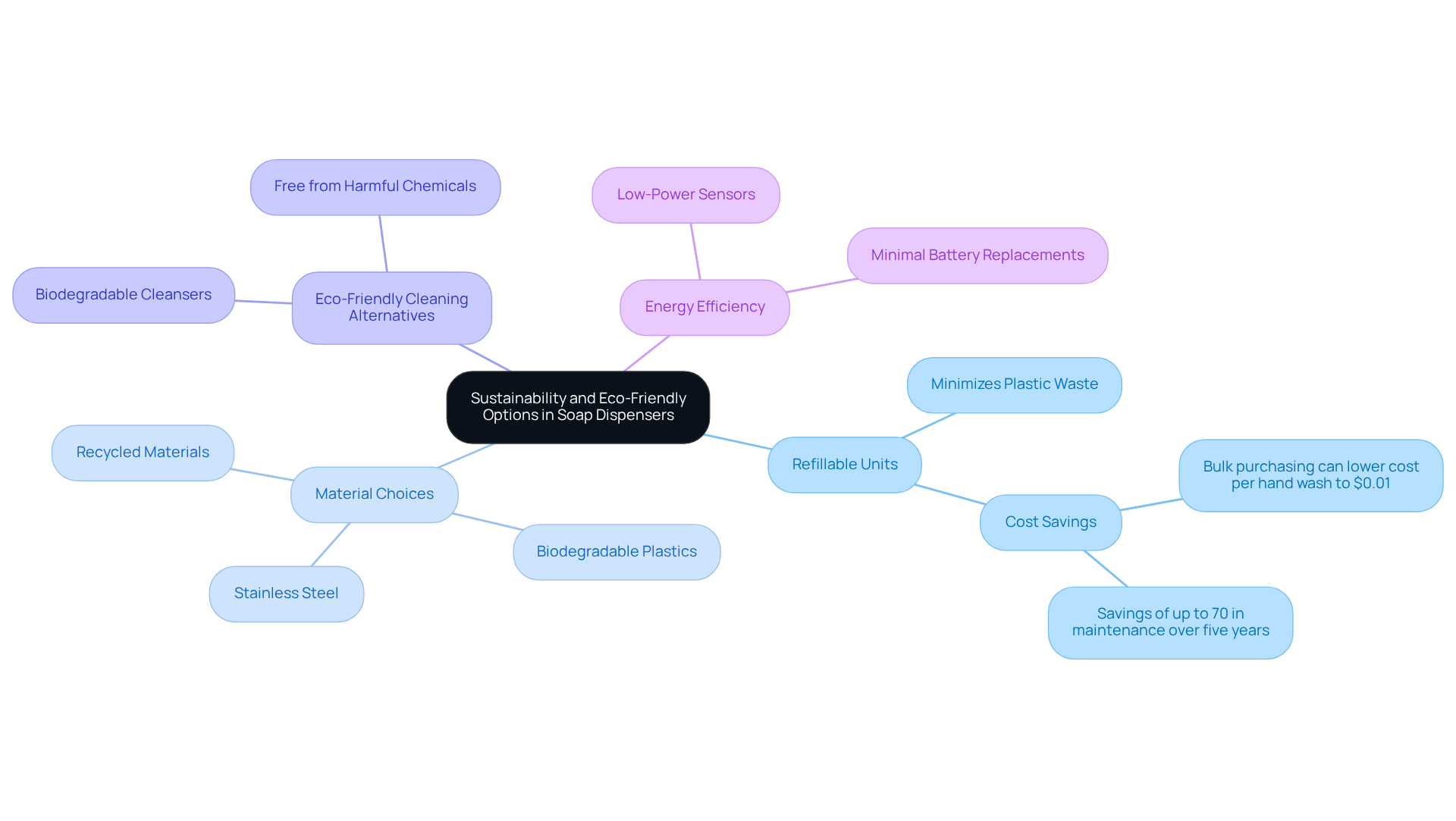Overview
When selecting the ideal commercial hand soap dispenser, it is essential to consider several key features:
- Capacity
- Dispensing mechanism
- Material durability
- Ease of use
- Maintenance requirements
Notably, choosing dispensers with larger capacities and touch-free mechanisms not only enhances hygiene but also reduces the frequency of refills. Furthermore, the use of durable materials guarantees longevity, thereby improving overall user satisfaction and operational efficiency. By prioritizing these attributes, businesses can ensure a seamless and effective hand hygiene solution.
Introduction
Choosing the right commercial hand soap dispenser is crucial for enhancing hygiene, user satisfaction, and operational efficiency within any business environment. With an abundance of options available—ranging from touch-free models to eco-friendly designs—understanding the key features and types of dispensers is essential for making an informed decision.
However, amid this myriad of choices, facility managers must consider how to select a dispenser that not only meets their unique needs but also aligns with sustainability goals and maintenance requirements.
This guide explores the critical considerations for selecting the ideal commercial hand soap dispenser, empowering businesses to improve cleanliness and functionality while fostering a commitment to a greener future.
Identify Key Features of Commercial Hand Soap Dispensers
When choosing a commercial hand soap dispenser, it is crucial to prioritize several key features to guarantee optimal functionality and user satisfaction.
-
Capacity: Opt for models with larger capacities to accommodate high restroom traffic, significantly reducing the need for frequent refills. Liquid soap containers typically range from 800ml to 2000ml, with common sizes between 1000ml and 1200ml, specifically designed for busy environments.
-
Dispensing Mechanism: Choose between manual and automatic devices. Automatic models, which offer touch-free operation, are increasingly favored for their ability to enhance hygiene by minimizing contact and reducing the risk of germ transmission. This trend aligns with the growing emphasis on maintaining high hygiene standards in commercial settings through the use of a commercial hand soap dispenser. Furthermore, a commercial hand soap dispenser reduces the necessity for regular refills, resulting in considerable long-term savings.
-
Material: Select devices constructed from durable materials such as stainless steel or premium plastics. These substances not only withstand heavy use but also resist corrosion, ensuring longevity and reliability in demanding environments.
-
Ease of Use: Ensure that the device is user-friendly, accommodating all users, including children and individuals with disabilities. Features like a consistent soap dispensing mechanism can significantly enhance user experience by delivering the same amount of soap with each use, preventing waste and ensuring satisfaction.
-
Maintenance: Consider the ease of refilling and cleaning the dispenser. Designs that minimize spills and mess can substantially reduce maintenance time and effort. For example, sealed cartridge systems, like those in Hillyard's Affinity line, mitigate contamination risks and simplify the refilling process. A commercial hand soap dispenser is vital for upholding hygiene standards in business environments.
Incorporating these features not only improves the restroom experience but also aligns with industry best practices, as evidenced by successful implementations in projects like Padel Haus and Lacuna Space, where tailored solutions effectively met specific operational needs while enhancing overall aesthetics.

Explore Types of Commercial Hand Soap Dispensers
When selecting commercial hand soap dispensers, it is crucial to evaluate the various types available, each tailored to meet specific needs:
-
Wall-Mounted Units: These devices are optimal for maximizing counter space and are available in both manual and automatic variations. Their design is particularly beneficial in high-traffic areas, where they contribute to maintaining cleanliness and accessibility. Research indicates that automatic wall-mounted devices significantly reduce the likelihood of cross-contamination, rendering them a sanitary choice for bustling environments. Additionally, their sleek designs enhance the overall aesthetic of the bathroom, aligning seamlessly with modern design trends.
-
Countertop Units: Positioned directly on the counter, these units offer convenient access and are ideal for smaller bathrooms or spaces where wall mounting is impractical. They are portable and easily refillable, making them a versatile option for various settings. Furthermore, their design can complement the restroom's overall appearance, contributing to a polished environment.
-
Freestanding Dispensers: Commonly found in larger establishments, freestanding dispensers can be placed anywhere, facilitating bulk liquid refills. Their adaptability allows for strategic positioning in busy locations, ensuring that the cleansing product is readily accessible when needed. The effectiveness of commercial hand soap dispensers in upholding hygiene standards while enhancing restroom design is illustrated by successful installations in facilities such as Padel Haus and Lacuna Space.
-
Foaming Liquid Dispensers: These units incorporate air into the solution, creating a light, frothy consistency that enhances lathering while using less product. This not only promotes sustainability but also reduces overall detergent consumption, making them a cost-effective solution for facilities. Many models feature refillable cartridges, further supporting eco-friendly practices.
-
Touch-Free Devices: Utilizing motion sensors, touch-free devices offer a hygienic solution by eliminating the need for physical contact. This feature is especially advantageous in environments where cleanliness is critical, as it minimizes the spread of germs and bacteria. Moreover, integrating visible alert systems for refill requirements can enhance the functionality of these units, ensuring that maintenance personnel can easily monitor liquid levels.
By recognizing the unique advantages of each type of device, architects and facility managers can make informed decisions that enhance cleanliness, functionality, and user experience in public restrooms.

Assess Installation and Maintenance Considerations
When evaluating installation and maintenance considerations for commercial soap dispensers, several key factors should be prioritized:
-
Installation Requirements: Assess whether the unit requires hardwiring or can function on batteries. Wall-mounted units are ideal for conserving counter space and typically necessitate secure installation, whereas a commercial hand soap dispenser in countertop versions merely needs a flat surface for support.
-
Accessibility: It is crucial to install units at heights that accommodate all users, with recommended heights ranging from 40 to 48 inches from the floor. In accessible washrooms, soap containers should be positioned between 30 to 40 inches to ensure ease of use for individuals with disabilities, aligning with accessibility standards.
-
For a commercial hand soap dispenser, regular cleaning and refilling are vital for optimal performance. Choose a commercial hand soap dispenser designed for easy access, allowing for rapid refills without spills. Automatic units may require periodic battery replacements and sensor adjustments to maintain functionality. Establishing a maintenance calendar is essential to prevent blockages and ensure longevity, as proactive maintenance is crucial.
-
Troubleshooting: Familiarize yourself with common issues such as clogs or malfunctioning pumps. Ensure that the device's design facilitates easy troubleshooting, allowing for quick resolution of issues. Regular maintenance, including cleaning of sensors and nozzles, is essential to prevent performance issues and maintain hygiene standards.

Consider Sustainability and Eco-Friendly Options
When prioritizing sustainability and eco-friendly options in commercial soap dispensers, it is essential to consider several key aspects:
-
Refillable Units: Opt for units designed for bulk liquid refills, significantly minimizing plastic waste associated with single-use cartridges. This approach not only reduces environmental impact but also results in cost savings over time; bulk purchasing can lower the cost per hand wash to as little as $0.01, compared to $0.03 or more for individual soap packets. Moreover, refillable containers can yield savings of up to 70% in maintenance and replacement costs compared to single-use systems over a five-year span.
-
Material Choices: Focus on dispensers made from recycled or sustainable materials, such as biodegradable plastics or stainless steel. These materials can be recycled at the end of their life cycle, contributing to a circular economy and reducing landfill waste. Examples of eco-friendly materials include post-consumer recycled plastics and sustainably sourced metals.
-
Eco-Friendly Cleaning Alternatives: Select biodegradable cleansers that are free from harmful chemicals, ensuring safety for both users and the environment. This choice aligns with the growing demand for eco-conscious products in business environments, particularly in hospitality, where cleanliness is paramount. As Jeremy Croff observes, "Explore the advantages of refillable commercial hand soap dispensers: minimize waste, lower expenses, and make an environmentally friendly decision for your business."
-
Energy Efficiency: For automatic dispensers, consider models that are energy-efficient, utilizing low-power sensors and requiring minimal battery replacements. This not only reduces operational costs but also supports sustainability initiatives by lowering energy consumption.
By integrating these eco-friendly practices, businesses can enhance their restroom environments while demonstrating a commitment to sustainability and responsible resource management.

Conclusion
Choosing the right commercial hand soap dispenser is essential for maintaining hygiene and enhancing user experience in any facility. By understanding the various features, types, installation considerations, and sustainability options, businesses can make informed decisions that align with their operational needs and values.
Key features such as capacity, dispensing mechanisms, and materials play a crucial role in the functionality and longevity of soap dispensers. The exploration of different types—including wall-mounted, countertop, and touch-free devices—provides valuable insights into how to optimize restroom cleanliness and accessibility. Furthermore, considering installation and maintenance factors ensures that the chosen dispenser operates efficiently and effectively over time.
Ultimately, investing in the right commercial hand soap dispenser not only improves hygiene standards but also reflects a commitment to sustainability and responsible resource management. By selecting eco-friendly options and prioritizing user-friendly designs, businesses can create a cleaner, safer environment while also contributing positively to the planet. Making these thoughtful choices today can lead to long-term benefits for both the facility and its users.
Frequently Asked Questions
What are the key features to consider when choosing a commercial hand soap dispenser?
Key features include capacity, dispensing mechanism, material, ease of use, and maintenance.
Why is capacity important for commercial hand soap dispensers?
Larger capacities are essential to accommodate high restroom traffic, reducing the need for frequent refills. Common sizes range from 800ml to 2000ml, with 1000ml to 1200ml being ideal for busy environments.
What are the differences between manual and automatic soap dispensers?
Manual dispensers require physical contact to operate, while automatic dispensers offer touch-free operation, enhancing hygiene by minimizing contact and reducing the risk of germ transmission.
What materials are recommended for commercial hand soap dispensers?
Durable materials such as stainless steel or premium plastics are recommended as they withstand heavy use and resist corrosion, ensuring longevity.
How can ease of use impact the effectiveness of a hand soap dispenser?
A user-friendly design accommodates all users, including children and individuals with disabilities. Consistent soap dispensing mechanisms enhance user experience by delivering the same amount of soap each time, preventing waste.
What maintenance considerations should be taken into account for soap dispensers?
Consider dispensers that are easy to refill and clean, with designs that minimize spills and mess. Sealed cartridge systems can help mitigate contamination risks and simplify the refilling process.
How do these features contribute to hygiene standards in commercial settings?
Incorporating these features improves the restroom experience and aligns with industry best practices, ensuring that hygiene standards are upheld in business environments.




